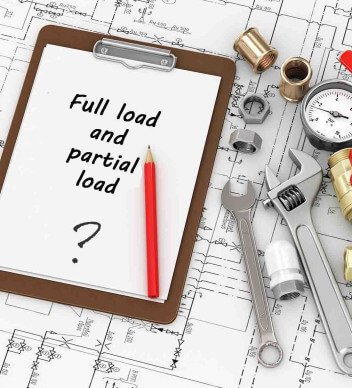Full load and partial load of a climate ceiling
Optimal adjustment of the systemAn important part of the application for a climate ceiling is the determination of the cooling and heating capacities to achieve the desired room temperatures in summer and winter. This is often referred to as full load and partial load. But what exactly does that mean? We explain it to you in this knowledge article.

What is the difference between full load and partial load?
To determine which cooling and heating capacities must be installed in order to achieve the desired room temperatures in summer and winter, cooling load and transmission calculations are made. This is based on the most unfavorable design outdoor conditions that occur in a calendar year. For cooling, the maximum occupancy and heat production of equipment is also assumed.
The results of these calculations are the cooling and heating capacities that the installation must be able to supply when the calculated (= maximum) capacities are required or in other words: during full load. How much time per year does a system run at full load? That is only 5 to 10% of the total time and this amounts to 30 to 40% of the 'use time' of a building (often 9:00 AM to 5:00 PM). This means that the installation functions for most of the time in a so-called partial load situation.
1. How does full load and partial load work with a climate ceiling?
The hydraulic design of climate ceilings is based on full load operation. If the climate ceiling is used for both heating and cooling, this is almost always full load in cooling mode. A climate ceiling is in fact a change-over system whereby both hot and cold water flows through the same circuit and more heat is usually released at the specified water routes than is required. This means that there is always a partial load in heating operation.
2. Calculation of water flow and realization of turbulent flow.
Because only a small part of the year requires the capacity on which the design of the climate ceiling is based, it must be possible to regulate the climate ceiling. We do this by calculating the water flows (amount of water that flows through the pipes per second) and determining how many panels can be connected in series. In these calculations, we assume full capacity capacities and the desired water trajectory. One of the design criteria here is turbulent flow in the climate elements. With turbulent flow, the water molecules move over the entire tube cross-section and a good heat transfer takes place between the water and the tube wall.
3. Restrict laminar flow
Often a flow control is applied whereby the amount of water per room or zone is reduced with a motorized control valve as less capacity is required (= partial load). The decrease in water flow rate means, however, that the flow velocity in the tube of the climate elements decreases and laminar flow can occur. Laminar flow occurs at low flow rates and is characterized by a layer of almost standing water along the tube wall. The heat transfer between the water and the pipe wall is negatively influenced by this and the flow resistance is lower than with turbulent flow. This results in:
- No homogeneous water and temperature distribution over the ceiling;
- Pendulum control valves;
- Air build-up in the flexible hoses.
4. Prevent negative consequences
To prevent such negative consequences, Inteco has simulated the above situation in its own climate chamber and on the basis of this selected relatively small pipe diameters (8 and 10 mm) for its climate systems. These diameters are ideal for full load and partial load because the laminar area is reached less quickly and the capacity decrease with laminar flow is small.
For each project, with the given design temperatures and capacities, Inteco determines the optimum series / parallel connections to realize a properly functioning climate ceiling in both cooling and heating companies.
Want to know more? Our advisors are here to answer your questions
If you have any questions about the design and operation of climate ceilings, please contact our advisors: they are there for you. You can ask your question via the contact form or by telephone.
contact us!View more articles from the knowledge base
In the Inteco knowledge base, we have collected more interesting articles for you that you will always learn. Sharing information = multiplying knowledge!
go to the knowledge base